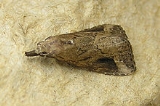
Schrankia costaestrigalis
Encyclopedia
The Pinion-streaked Snout (Schrankia costaestrigalis) is a species of moth
of the family Noctuidae
. It is found in Europe
. The species closely resembles Crambidae
or Pyralidae
species.
The wingspan
is 16-22 mm. The length of the forewings is 9-11 mm. The moth flies from May to October depending on the location.
The larvae feed on various herbaceous and woody plants.
Moth
A moth is an insect closely related to the butterfly, both being of the order Lepidoptera. Moths form the majority of this order; there are thought to be 150,000 to 250,000 different species of moth , with thousands of species yet to be described...
of the family Noctuidae
Noctuidae
The Noctuidae or owlet moths are a family of robustly-built moths that includes more than 35,000 known species out of possibly 100,000 total, in more than 4,200 genera. They constitute the largest family in the Lepidoptera....
. It is found in Europe
Europe
Europe is, by convention, one of the world's seven continents. Comprising the westernmost peninsula of Eurasia, Europe is generally 'divided' from Asia to its east by the watershed divides of the Ural and Caucasus Mountains, the Ural River, the Caspian and Black Seas, and the waterways connecting...
. The species closely resembles Crambidae
Crambidae
The Crambidae are the grass moth family of Lepidoptera . They are quite variable in appearance, the nominal subfamily Crambinae taking up closely folded postures on grass-stems where they are inconspicuous, while other subfamilies include brightly coloured and patterned insects which rest in...
or Pyralidae
Pyralidae
The Pyralidae or snout moths are a family of Lepidoptera in the ditrysian superfamily Pyraloidea. In many classifications, the grass moths are included in the Pyralidae as a subfamily, making the combined group one of the largest families in the Lepidoptera...
species.
The wingspan
Wingspan
The wingspan of an airplane or a bird, is the distance from one wingtip to the other wingtip. For example, the Boeing 777 has a wingspan of about ; and a Wandering Albatross caught in 1965 had a wingspan of , the official record for a living bird.The term wingspan, more technically extent, is...
is 16-22 mm. The length of the forewings is 9-11 mm. The moth flies from May to October depending on the location.
The larvae feed on various herbaceous and woody plants.

